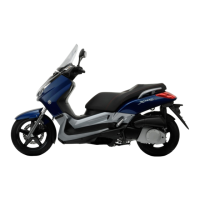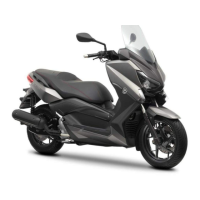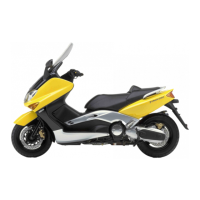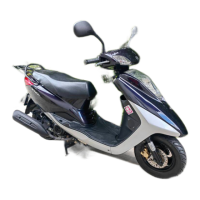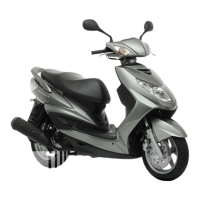Do you have a question about the Yamaha XMAX YP250R and is the answer not in the manual?
Guidance for owners on safe operation, visibility, and riding practices.
Essential protective gear and information on carbon monoxide risks.
Guidelines for loading cargo and considerations for accessories.
Advice on tires, transport, aftermarket parts and modifications.
Further advice on safe operation, including braking, load management, and specific points.
Diagram and labels for the left side of the scooter.
Diagram and labels for the right side of the scooter.
Identification of handlebar controls, levers, and dashboard instruments.
Explanation of the vehicle's anti-theft immobilizer system and key usage.
Operation of the ignition switch, lighting systems, and steering lock mechanism.
Detailed steps for locking steering and using the parking mode.
Description and function of various dashboard indicator and warning lights.
Functionality and behavior of ABS and immobilizer indicator lights.
Overview of the dashboard display, including speedometer, tachometer, and other meters.
Details on speed, RPM display, fuel meter, and setting the clock.
Explanation of the odometer, various tripmeters, and how to navigate between them.
Procedures for resetting oil change and V-belt replacement indicators.
Displaying ambient temperature, battery voltage, and average fuel consumption.
Displaying and understanding real-time fuel consumption and average speed.
Function of the self-diagnosis system and the coolant temperature meter.
Location and correct use of the front brake lever.
Operation of the rear brake lever and how to use the ABS system.
Notices on ABS system magnets and fuel tank cap operation.
Safety guidelines for refueling, recommended fuel, and tank capacity.
Information on fuel types, gasohol, and the vehicle's catalytic converters.
Procedures for opening and closing the scooter seat.
How to open, close, and lock front and rear storage compartments.
Maximum storage weight limits and how to adjust rear shock absorbers.
Checking the sidestand's function and its role in the ignition cut-off system.
Explanation of how the system prevents starting or stops the engine based on conditions.
Procedure to test the functionality of the ignition circuit cut-off system.
Pre-ride checks for fuel, oil, coolant, brakes, tires, wheels, chassis, and instruments.
Checks for wheels, tires, chassis fasteners, instruments, and sidestand switch.
Importance of understanding controls and the function of the lean angle sensor.
Step-by-step instructions for starting the engine, including indicator light checks.
Procedure for moving off and adjusting speed using the throttle.
Safe braking procedures, including warnings about wet roads and sudden stops.
Advice on fuel efficiency and crucial guidelines for the engine break-in period.
Safe practices for parking the scooter, considering hot components and location.
Overview of how periodic inspection, adjustment, and lubrication ensure safety and efficiency.
Information on maintenance schedules, emission controls, and the owner's tool kit.
Schedule for checks and maintenance of emission control components.
Schedule for general maintenance tasks and lubrication points.
Detailed maintenance items and intervals for various components like brakes, wheels, engine oil.
Checks for lights, switches, and important notes on hydraulic brake service.
Instructions for accessing components by removing body panels.
Procedures for checking, installing spark plugs, and changing engine oil.
Procedures for checking and changing final transmission oil and coolant levels.
Maintenance of coolant, air filters, brakes, cables, and throttle grip.
Information on tires, wheels, and checking brake lever free play.
Checking brake pad wear, fluid levels, and procedures for changing brake fluid.
Lubricating cables, levers, stands, and checking front fork and steering.
Checking wheel bearings, battery maintenance, and replacing fuses.
Replacing bulbs, troubleshooting guides, and addressing engine overheating.
Instructions for cleaning the scooter, windshield, and post-wash care.
Guidelines for short-term and long-term storage of the scooter.
Vehicle dimensions, weight, engine type, oil recommendations, and quantities.
Technical details on chassis, wheels, brakes, electrical system, battery, and lighting.
Location and importance of vehicle identification and model labels.
Guidance for owners on safe operation, visibility, and riding practices.
Essential protective gear and information on carbon monoxide risks.
Guidelines for loading cargo and considerations for accessories.
Advice on tires, transport, aftermarket parts and modifications.
Further advice on safe operation, including braking, load management, and specific points.
Diagram and labels for the left side of the scooter.
Diagram and labels for the right side of the scooter.
Identification of handlebar controls, levers, and dashboard instruments.
Explanation of the vehicle's anti-theft immobilizer system and key usage.
Operation of the ignition switch, lighting systems, and steering lock mechanism.
Detailed steps for locking steering and using the parking mode.
Description and function of various dashboard indicator and warning lights.
Functionality and behavior of ABS and immobilizer indicator lights.
Overview of the dashboard display, including speedometer, tachometer, and other meters.
Details on speed, RPM display, fuel meter, and setting the clock.
Explanation of the odometer, various tripmeters, and how to navigate between them.
Procedures for resetting oil change and V-belt replacement indicators.
Displaying ambient temperature, battery voltage, and average fuel consumption.
Displaying and understanding real-time fuel consumption and average speed.
Function of the self-diagnosis system and the coolant temperature meter.
Location and correct use of the front brake lever.
Operation of the rear brake lever and how to use the ABS system.
Notices on ABS system magnets and fuel tank cap operation.
Safety guidelines for refueling, recommended fuel, and tank capacity.
Information on fuel types, gasohol, and the vehicle's catalytic converters.
Procedures for opening and closing the scooter seat.
How to open, close, and lock front and rear storage compartments.
Maximum storage weight limits and how to adjust rear shock absorbers.
Checking the sidestand's function and its role in the ignition cut-off system.
Explanation of how the system prevents starting or stops the engine based on conditions.
Procedure to test the functionality of the ignition circuit cut-off system.
Pre-ride checks for fuel, oil, coolant, brakes, tires, wheels, chassis, and instruments.
Checks for wheels, tires, chassis fasteners, instruments, and sidestand switch.
Importance of understanding controls and the function of the lean angle sensor.
Step-by-step instructions for starting the engine, including indicator light checks.
Procedure for moving off and adjusting speed using the throttle.
Safe braking procedures, including warnings about wet roads and sudden stops.
Advice on fuel efficiency and crucial guidelines for the engine break-in period.
Safe practices for parking the scooter, considering hot components and location.
Overview of how periodic inspection, adjustment, and lubrication ensure safety and efficiency.
Information on maintenance schedules, emission controls, and the owner's tool kit.
Schedule for checks and maintenance of emission control components.
Schedule for general maintenance tasks and lubrication points.
Detailed maintenance items and intervals for various components like brakes, wheels, engine oil.
Checks for lights, switches, and important notes on hydraulic brake service.
Instructions for accessing components by removing body panels.
Procedures for checking, installing spark plugs, and changing engine oil.
Procedures for checking and changing final transmission oil and coolant levels.
Maintenance of coolant, air filters, brakes, cables, and throttle grip.
Information on tires, wheels, and checking brake lever free play.
Checking brake pad wear, fluid levels, and procedures for changing brake fluid.
Lubricating cables, levers, stands, and checking front fork and steering.
Checking wheel bearings, battery maintenance, and replacing fuses.
Replacing bulbs, troubleshooting guides, and addressing engine overheating.
Instructions for cleaning the scooter, windshield, and post-wash care.
Guidelines for short-term and long-term storage of the scooter.
Vehicle dimensions, weight, engine type, oil recommendations, and quantities.
Technical details on chassis, wheels, brakes, electrical system, battery, and lighting.
Location and importance of vehicle identification and model labels.
| Engine Type | Liquid-cooled, 4-stroke, SOHC, 4-valve |
|---|---|
| Displacement | 249 cc |
| Bore x Stroke | 69.0 mm x 66.8 mm |
| Compression Ratio | 10.5:1 |
| Fuel System | Fuel Injection |
| Ignition System | TCI |
| Transmission | V-Belt Automatic |
| Front Suspension | Telescopic fork |
| Rear Suspension | Swingarm |
| Front Tire | 120/70-15 |
| Rear Tire | 140/70-14 |
| Fuel Tank Capacity | 13.2 liters |
| Seat Height | 785 mm |
| Wet Weight | 179 kg |
| Length | 2, 160 mm |
| Width | 790 mm |
| Height | 1, 385 mm |
| Wheelbase | 1, 545 mm |
| Front Brake | Hydraulic Disc |
| Rear Brake | Hydraulic Disc |

